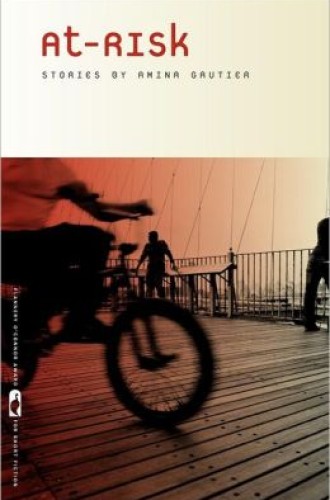At-Risk, by Amina Gautier
The African-American children and teens in these potent stories are all at risk all of the time. Most readers who pick up this book already know about the dangers that these youths face as residents of a Brooklyn housing project: drug addiction and trafficking, gun violence and teen pregnancy. But most don’t know what it’s like to be them, to live minute to minute and day to day in a perilous setting. How do these youth find friends? How do they see their own neighborhoods and understand themselves in their setting? How are they pulled under from safety and innocence into the dangers that tug at them?
The power of these stories is in the way they portray that undertow. Amina Gautier pulls us inside the characters’ lives so we learn—she said in an interview with Pif magazine—“what they don’t want anyone else to know about them.” The characters include a teenager who’s afraid of his peers’ bullying, a restless teen mom who just wants to be a teen, a young man who knows that his friends will get him in trouble but who needs their companionship.
Read our latest issue or browse back issues.
Gautier grew up in Brooklyn, in the 1980s and ’90s, and she plumbs her experiences in these stories, taking readers with her into the unnerving tension of lives caught between internal turmoil and the culture’s outside dangers. Now she lives in Chicago and teaches at DePaul University. Her stories have appeared in the Southern Review, Kenyon Review and other literary magazines. At-Risk, her first collection of stories, won the Flannery O’Connor Award for Short Fiction.
The dangers lurking around Gautier’s characters hover as close as the puffs of the cigarette a mother smokes, or as the fear when a car slows on its way through the neighborhood, or as the surprise flare of a firecracker that a kid has set off in the park across the street. And yet a period with such dangers is just another afternoon spent sitting on the curb, watching TV or shouting insults at the neighborhood boys or girls. The more subtle dangers here are loneliness, restlessness, temptation and despair. A teenage boy is afraid of being trapped in an apartment with his mother. A teenage mom is afraid of being suddenly isolated and ignored.
In “Boogiemen,” two fatherless brothers, nine and 12, are enduring taunts and threats from their peers even as an ironclad protective bond is developing between them. In “Girl of Wisdom,” two 15-year-old girls sit on a stoop calling out to boys and then taunting them. We don’t know the girls’ names (they’re already anonymous?), but their insults are innocent. “Your breath stinks so bad I can smell it from across the street!” Then one girl shouts something more suggestive to an older man who is watching them as he drives by, and he slows down.
Chandra calls out to him, “Hey Pops!
My friend says she likes you.”
“Stop,” Melanie whispers.
The man looks at them, shaking his head in annoyance.
“For real!” Chandra cries.
“Then let her say it herself,” the man says, his voice carrying.
Is the episode a foolish game or an entry point into prostitution? And just where is the line for this lonely, bored 15-year-old girl?
The sickening proximity of violence comes closest in “The Ease of Living,” when 15-year-old Jason sees two of his friends accidentally killed by gunfire. Jason’s not an innocent kid—his friends sell weed, steal Social Security checks and father kids—and he is a follower; he wants to keep up with them. Although he knows he’s headed into trouble, he can’t connect his behavior with the deaths he’s seen. He needs friends.
Desperate, his mother takes precious dollars and sends him south to live with his elderly, disabled grandfather. His grandfather is able to talk tough love to this boy/man who is ambushed by nightmares and confused about what to do with himself. But the trip south is only a brief oasis in Jason’s life. What will happen next, when his grandfather dies, or when he goes home?
In “Yearn,” which ends the collection, 12-year-old Stephen lives in a neighborhood where everyone comes out at night. Teenagers flirt. Old men sit on the building stoop, and Stephen sees them every day. “His father could have been any of them—one day—if he had stayed.” “Just once, he wanted to pull that shade up and not see them sitting there like always. He wanted his mother not to have to worry about him, not to have to cry.”
Yet Stephen is pulled out of the apartment where his beloved mother and grandmother are trying to keep him safe and outside, past the unemployed men, to the excitement of being with Kiki, a friend who always has plenty of cash and access to girls. “His mother was too worried about too may things. . . . The way [the boys] wore their jeans so low that they seemed to hang off their narrow behinds. And the way they carried pagers and cell phones as if they were doctors and lawyers even though they had no jobs and nowhere to go.”
Stephen and Kiki are the names of the two boys who are killed in the first story. In the last story, we’ve been handed an eerie, unsettling flashback and the despair of wanting to change the story’s ending but being powerless to do so. We may know who these boys are, and we may love them, but we can’t help them to a safe place. Instead we’re back at the beginning. “It was barely the summer—just the end of June—and already two teenaged boys had been killed.” We’ve gotten to know some of the kids who are at risk all of the time.







